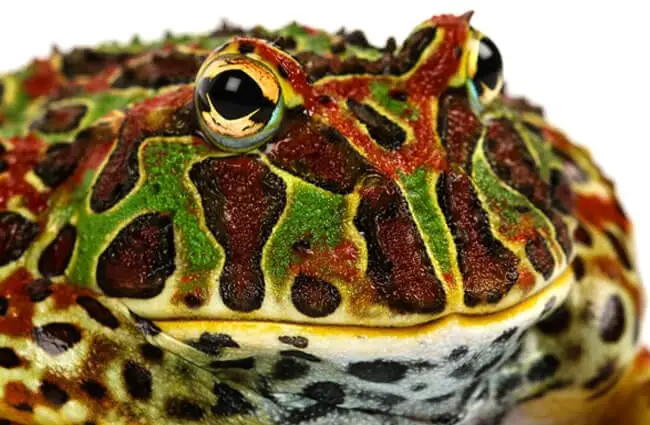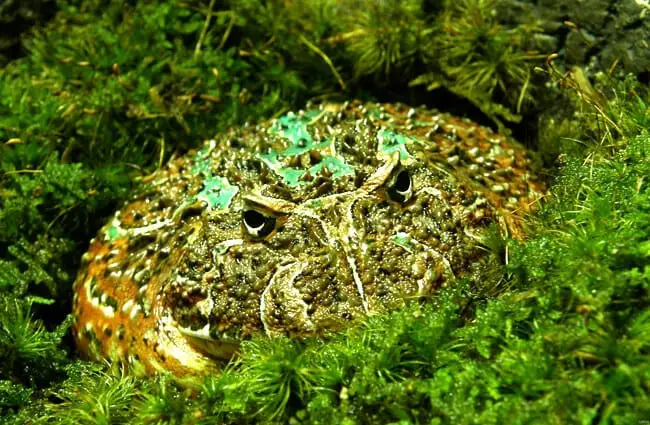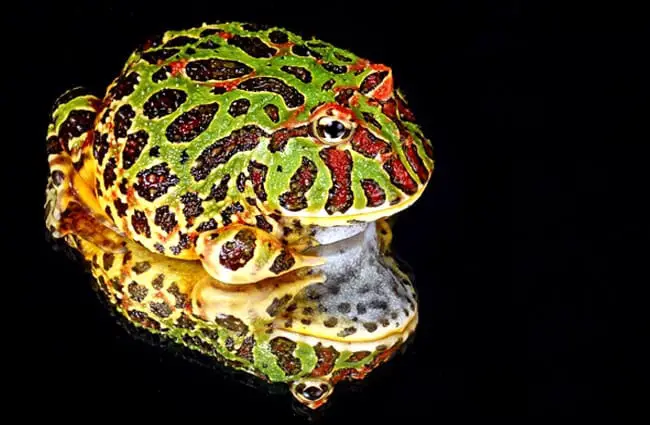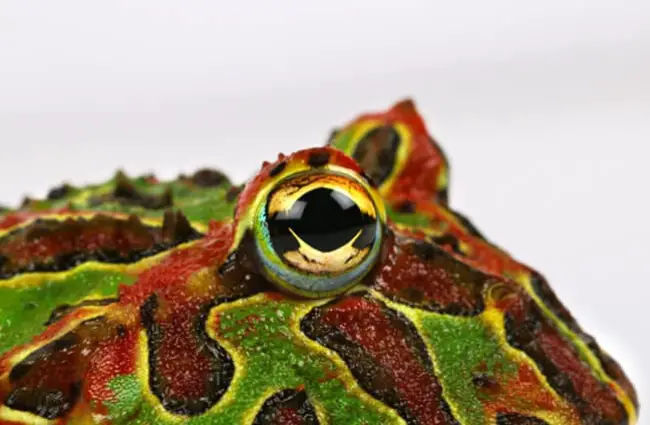The Mighty Mouth of the Amazon: Unpacking the Pacman Frog
Deep within the verdant embrace of South America’s forests and grasslands lurks an amphibian marvel, a creature whose very name conjures images of a classic arcade character: the Pacman Frog. With its disproportionately large mouth and stout, often vibrantly colored body, this frog is not just a visual spectacle but a master of ambush, a living testament to evolutionary ingenuity. Join us on a journey to uncover the secrets of these fascinating amphibians, from their ancient lineage to their vital role in the ecosystem, and even their surprising popularity in human homes.

Who Are These Amphibian Ambushers? Basic Biology
A Name That Sticks: Taxonomy and Common Names
The creatures commonly known as Pacman Frogs belong to the genus Ceratophrys, a group within the family Ceratophryidae. While “Pacman Frog” is a widely recognized moniker, inspired by their wide, gaping mouths, they are also known by other descriptive names such as Horned Frogs, Ornate Horned Frogs, and the Argentine Wide-mouth Frog, particularly referring to Ceratophrys ornata and Ceratophrys cranwelli, two of the most popular species in captivity. These names aptly describe their most striking features: the often horn-like projections above their eyes and their impressive oral cavity.
Physical Characteristics: Built for the Hunt
Pacman Frogs are instantly recognizable. They possess a remarkably round, stout body, short limbs, and an enormous mouth that can span nearly the entire width of their head. Their size varies by species, but adult individuals can range from 2 to 8 inches (5 to 20 cm) in length, with females generally being larger than males. Their skin is typically rough and warty, providing excellent camouflage. Coloration is incredibly diverse, ranging from dull browns, greens, and tans to vibrant patterns of red, orange, and yellow, often mottled or striped to blend seamlessly with leaf litter and forest floor debris. Some species, like the Cranwell’s Horned Frog, exhibit a wide array of captive-bred color morphs, including albino and strawberry varieties. Sexual dimorphism is present, with males often developing dark nuptial pads on their thumbs during breeding season, which aid in grasping the female.

Where the Wild Things Are: Habitat and Distribution
Geographic Range: South America’s Green Heart
The natural domain of the Pacman Frog is exclusively South America. Different species occupy various regions, but their collective range spans across countries such as Argentina, Brazil, Uruguay, Paraguay, and Bolivia. They are true inhabitants of the Neotropics, thriving in environments characterized by warmth and humidity.
Preferred Environment: Masters of the Forest Floor
These frogs are primarily terrestrial, meaning they spend most of their lives on the ground. Their preferred habitats include tropical and subtropical rainforests, humid grasslands, swamps, and marshy areas. They are not typically found climbing or swimming extensively. Instead, they are masters of concealment, often found partially or fully buried in soft soil, leaf litter, or moss, with only their eyes and the top of their head exposed. This burrowing behavior is crucial for both ambush predation and for regulating their body temperature and moisture levels, especially during drier periods. Their robust bodies and short, powerful legs are perfectly adapted for digging backward into the substrate.
A Glimpse into the Past: Evolutionary Journey
Ancient Lineage: A Survivor’s Tale
The Ceratophryidae family, to which Pacman Frogs belong, represents an ancient lineage of amphibians. Their evolutionary history is deeply intertwined with the development of the South American continent. Their unique morphology, particularly their massive mouths and ambush predatory strategy, are long-standing adaptations that have allowed them to thrive for millions of years. These frogs are considered “fossorial” or burrowing specialists, a trait that likely evolved to cope with fluctuating environmental conditions, including periods of drought. Their robust build and powerful jaws suggest a lineage that has consistently relied on a sit-and-wait hunting technique, a strategy that has proven highly successful in their diverse ecosystems.
What’s on the Menu? Diet and Feeding Habits
The Ultimate Ambush Predator
Pacman Frogs are obligate carnivores and epitomize the “sit-and-wait” predator. They remain motionless, often buried, for extended periods, patiently waiting for unsuspecting prey to wander within striking distance. When an opportunity arises, they launch a lightning-fast attack, using their powerful jaws and sticky tongue to engulf their victim whole. Their bite force is surprisingly strong for an amphibian of their size, capable of subduing relatively large prey.
A Diverse Palate
Their diet in the wild is incredibly varied, reflecting their opportunistic nature. It includes a wide array of invertebrates such as large insects, spiders, and earthworms. However, they are also known to consume small vertebrates, including rodents, other frogs (even smaller Pacman Frogs, demonstrating cannibalistic tendencies), lizards, small snakes, and even fish if they are near water. This broad diet highlights their role as a significant predator within their microhabitat, helping to regulate populations of various smaller animals.

Love in the Litter: Mating and Reproduction
Seasonal Rhythms: The Call to Mate
Reproduction in Pacman Frogs is typically tied to the rainy season in their native habitats. The increased humidity and availability of temporary pools of water signal the ideal conditions for breeding. During this time, male Pacman Frogs emit loud, distinctive croaks and calls to attract females. These vocalizations are crucial for species recognition and mate selection.
Amplexus and Egg Laying
Once a female is attracted, the male will engage in amplexus, a mating embrace where he grasps the female from behind, typically around her waist. This position ensures the fertilization of eggs as they are laid. The female then deposits a large clutch of eggs, often numbering in the hundreds or even thousands, in shallow water, frequently in temporary ponds or flooded areas. These eggs are usually dark-colored and adhere to submerged vegetation or debris.
Tadpole Development and Metamorphosis
The eggs hatch into tadpoles relatively quickly, a necessary adaptation for survival in ephemeral water bodies. Pacman Frog tadpoles are also carnivorous, preying on smaller aquatic invertebrates and even other tadpoles. They undergo rapid development, metamorphosing into miniature froglets within a few weeks to months, depending on species and environmental conditions. These froglets then emerge from the water to begin their terrestrial lives, already equipped with the predatory instincts of their parents.
Nature’s Role: Ecosystem Contribution and Interactions
Predator and Prey: A Balancing Act
In their natural environment, Pacman Frogs play a significant role as apex predators within their specific niche. By consuming a wide variety of insects, spiders, and small vertebrates, they help to control populations of these animals, contributing to the overall balance and health of the ecosystem. Their presence can influence the distribution and behavior of their prey species. Conversely, Pacman Frogs themselves can fall prey to larger predators, such as snakes, birds of prey, and certain mammals, forming an integral part of the food web.
Burrowing Benefits
Beyond their predatory role, their burrowing habits also contribute to the ecosystem. By digging into the soil, they help to aerate it, which can improve soil health and facilitate the decomposition of organic matter. This seemingly simple action can have cascading effects on plant growth and nutrient cycling within their habitat.
The Pacman Frog and Humanity
Cultural Significance and Human Interaction
Unlike some other charismatic megafauna, Pacman Frogs do not hold widespread cultural significance in indigenous folklore or traditions. They are generally perceived as part of the natural fauna, sometimes encountered by locals as a curiosity. However, their unique appearance has garnered them considerable attention in the global pet trade, leading to a different kind of human interaction.
Conservation Status
The conservation status of Pacman Frog species varies. Many, such as Ceratophrys cranwelli, are listed as “Least Concern” by the IUCN, largely due to their wide distribution and adaptability. However, like many amphibians, they face threats from habitat loss and degradation due to deforestation, agriculture, and urbanization. The pet trade, if unregulated, could also pose a risk, but most captive-bred individuals alleviate pressure on wild populations. Responsible breeding and ownership are key to ensuring their long-term survival.
Popularity as Pets: A Captive Audience
Pacman Frogs have become incredibly popular exotic pets. Their striking appearance, relatively manageable size, and generally docile nature make them appealing to amphibian enthusiasts. Their unique feeding behavior and vibrant color morphs further contribute to their allure. This popularity underscores the importance of understanding their specific needs to ensure their welfare in captivity.

Encountering a Pacman Frog in the Wild: A Guide for Explorers
Where and How to Spot Them
For the adventurous animal lover or aspiring zoologist hoping to find a Pacman Frog in its natural habitat, patience and keen observation are paramount. Focus your search on their preferred environments: damp, humid forest floors, grasslands, or marshy areas in South America, particularly during or after rainfall. Look for areas with thick leaf litter, soft soil, or dense vegetation near temporary or permanent water sources. They are primarily nocturnal or crepuscular, meaning they are most active at dusk, dawn, or during the night. During the day, they will likely be buried, so look for subtle disturbances in the substrate or listen for their distinctive calls during the breeding season.
Respectful Observation: What to Do (and Not Do)
If you are fortunate enough to encounter a Pacman Frog in the wild, remember that you are a guest in its home.
- Observe from a distance: Maintain a respectful distance to avoid stressing the animal or altering its natural behavior.
- Do not touch or handle: Amphibian skin is delicate and permeable. Oils, lotions, or chemicals on human hands can be harmful to them.
- Leave the habitat undisturbed: Avoid moving logs, rocks, or disturbing leaf litter unnecessarily. Their camouflage is their primary defense.
- Photography: Use natural light if possible and avoid flash photography that might startle or disorient the frog.
- Report sightings: If you are part of a research expedition, follow protocols for reporting observations. Otherwise, simply enjoy the rare privilege of witnessing this unique amphibian in its natural setting.
Caring for a Pacman Frog in Captivity: A Zookeeper’s Handbook
For zookeepers and dedicated hobbyists, providing optimal care for a Pacman Frog involves replicating its natural environment as closely as possible. These guidelines ensure the health and well-being of these fascinating amphibians.
Creating the Perfect Habitat: Terrarium Setup
- Enclosure Size: A single adult Pacman Frog requires a minimum of a 10-gallon terrarium, though a 20-gallon long is often preferred to allow for ample substrate depth and decor.
- Substrate: A deep layer (at least 4-6 inches) of moisture-retaining substrate is crucial for burrowing. Ideal choices include coco fiber, sphagnum moss, cypress mulch, or a soil mix. Avoid gravel or small particles that could be ingested.
- Hides and Water: Provide a shallow, sturdy water dish that the frog can easily enter and exit, large enough for it to soak in. Offer artificial plants or cork bark for additional cover, though they primarily burrow.
- Temperature: Maintain an ambient temperature between 75-82°F (24-28°C) during the day, with a slight drop at night. Use an undertank heater or ceramic heat emitter with a thermostat.
- Humidity: High humidity, around 70-85%, is essential. This can be achieved through daily misting with dechlorinated water and appropriate substrate. A hygrometer is vital for monitoring.
- Lighting: While not strictly necessary, a low-level UVB light (2.0 or 5.0) for a few hours a day can be beneficial for overall health and vitamin D3 synthesis. A regular day/night cycle should be maintained.
Feeding Regimen: A Balanced Diet
- Live Prey: Pacman Frogs thrive on a diet of live, appropriately sized insects such as crickets, dubia roaches, and earthworms. For larger adults, occasional feeder mice (pinkies or fuzzies) or small fish can be offered, but these should be infrequent treats due to their high fat content.
- Supplementation: Dust prey items with a calcium supplement (without D3) at every other feeding for juveniles, and 2-3 times a month for adults. A multivitamin supplement should be used once a week for juveniles and 1-2 times a month for adults.
- Feeding Frequency: Juveniles should be fed every 2-3 days, while adults can be fed 1-2 times a week. Adjust frequency based on the frog’s body condition and activity level.
Health and Hygiene: Essential Care
- Cleaning: Spot clean the enclosure daily, removing any uneaten food or waste. Perform a full substrate change every 4-6 weeks to prevent bacterial buildup.
- Water Quality: Provide fresh, dechlorinated water in the water dish daily.
- Monitoring: Regularly observe the frog for signs of illness, such as lethargy, refusal to eat, unusual skin discoloration, swelling, or difficulty breathing. Consult a reptile and amphibian veterinarian for any concerns.
- Handling: Minimize handling as much as possible. If handling is necessary, wear powder-free gloves and ensure your hands are clean and free of chemicals. Their skin is sensitive, and they can be prone to stress.
What to Avoid
- Overhandling: Causes stress and can damage their delicate skin.
- Wild-caught insects: May carry parasites or pesticides harmful to the frog.
- Inappropriate substrate: Gravel or small wood chips can cause impaction if ingested.
- Co-habitation: Pacman Frogs are solitary and cannibalistic; never house more than one together.
- Extreme temperatures or humidity fluctuations: Can lead to respiratory issues or skin problems.
- Tap water without dechlorinator: Chlorine and chloramines are toxic to amphibians.

Fascinating Facts About Pacman Frogs
- Their bite can be surprisingly strong, capable of drawing blood, especially from larger species.
- They can live for over 10 years in captivity with proper care, far exceeding their wild lifespan.
- During dry periods, they can undergo aestivation, forming a hardened cocoon of shed skin to retain moisture and survive until conditions improve.
- Their skin can be quite rough and warty, providing excellent camouflage and some protection.
- They are often mistaken for inanimate objects like rocks or clumps of leaves due to their exceptional camouflage and motionless hunting style.
- Some species are specifically known as “South American Horned Frogs” due to the distinctive horn-like projections above their eyes.
- They are capable of consuming prey nearly their own body size, a testament to their incredibly wide mouths and powerful jaws.
- Their eyes are positioned high on their head, allowing them to remain mostly buried while still having a clear view of their surroundings for ambush.
- Despite living near water, they are not strong swimmers and prefer to stay on land.
- They are solitary creatures, only coming together for breeding purposes.
Conclusion: The Enduring Allure of the Pacman Frog
From the depths of the South American rainforests to the carefully curated terrariums of enthusiasts worldwide, the Pacman Frog stands as a testament to nature’s boundless creativity. Its unique appearance, formidable predatory skills, and fascinating life cycle make it a subject of endless intrigue for zoologists, a captivating challenge for zookeepers, and a source of wonder for anyone who encounters it. Understanding these “mighty mouths” not only enriches our appreciation for amphibian diversity but also underscores the critical importance of conservation efforts to protect their habitats and ensure their continued survival for generations to come.

![Red Angus Closeup of a beautiful Red Angus cowPhoto by: U.S. Department of Agriculture [pubic domain]https://creativecommons.org/licenses/by/2.0/](https://animals.net/wp-content/uploads/2020/03/Red-Angus-4-238x178.jpg)




![Red Angus Closeup of a beautiful Red Angus cowPhoto by: U.S. Department of Agriculture [pubic domain]https://creativecommons.org/licenses/by/2.0/](https://animals.net/wp-content/uploads/2020/03/Red-Angus-4-100x75.jpg)

